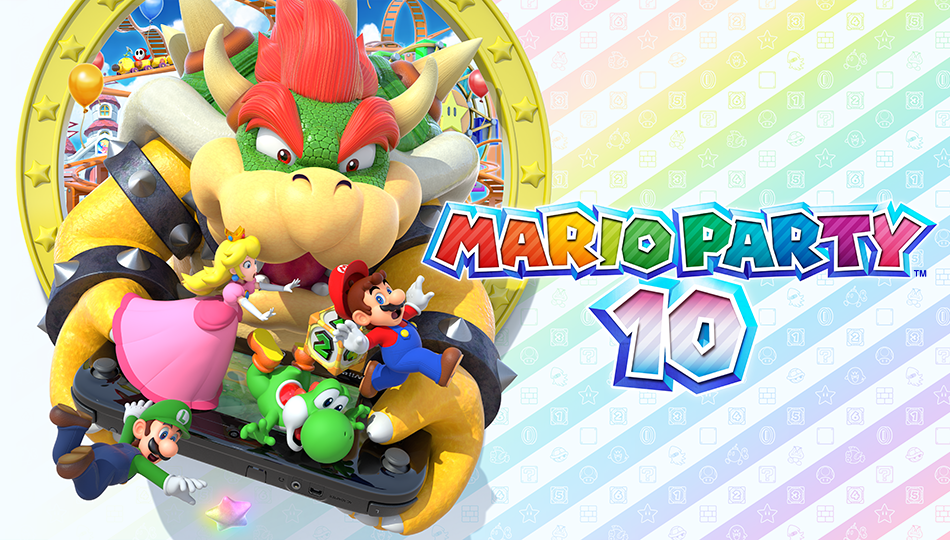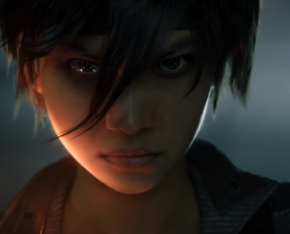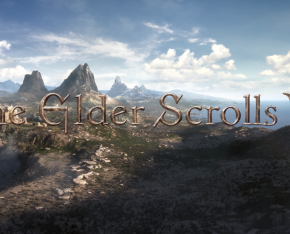By Anni Simpson on March 22, 2015 at 7:49pm
Three heroes battled their way through all three modes to save the day from the wrathful Bowser and his spawn Bowser Jr. (Who mated with Bowser in the first place?) – Yosh420Swag (Yoshi), Papaya (Peach), and Toad (Toad). Together, they undertook each challenge to better understand the universe that is the latest rendition of “Mario Party” for Wii U – regular mode, Amiibo Party, and Bowser Party.
Regular Mode
The closest thing to a default mode in the game, players in regular hop in a car together and trek across one of a handful of maps. The goal is simple – whoever has the most stars at the end of the map wins. A mini-boss battle, Bowser Jr penalties, and mini-games can all impact a player’s score heavily over the smallest incorrect (or brilliant) move. However, none of these challenges are complicated or difficult to understand. Even though we practiced every mini-game before we played it, they weren’t difficult either. Order was chosen at random by the computer (who was randomly selected to pick turn order).
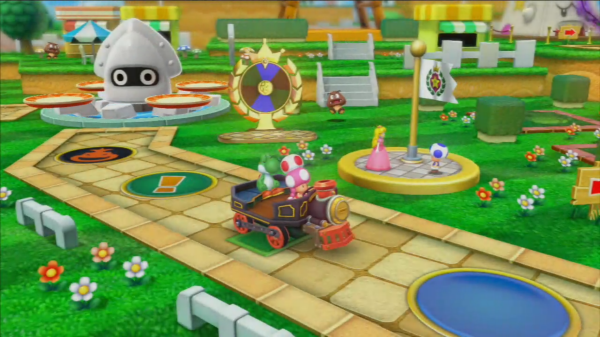
What resulted was a pathetic excuse for an adventure. On a map identical to other maps in terms of routes available, we powered through the entire campaign in approximately 15 minutes including the four mini-games (or so) we got to play. Whatever the actual count was, it was under the 10 guaranteed by amiibo mode. This is a mode you want to play if you’re doing something that requires your attention instead, the sort of thing that stands in for background noise to help you concentrate on a task that actually matters, unlike this method of play.
The only redeeming feature is at least the mini-games were new – with none being repeated from previous iterations of the series – but that was something our party enjoyed in the other, much more enjoyable modes.
Amiibo Party Mode
With my sympathy bar half-drained, we dredged ourselves into Amiibo Party, which seemed to be the most “classic” of the current modes. The game is a small, 10-round match with a guaranteed mini-game after everyone has taken their turn. The maps are, again, identical with the exception of small changes determined by “who’s” map it is – Toad’s, Peach’s, or whoever’s. As with the regular mode, your character can gather up to three sets of special dice (e.g., slow, 0-1, double, 1-3, or 4-6) dice and one “token” that changes gameplay. The entire game relies on the use of your amiibos, so have those ready in the wings before you do absolutely anything.
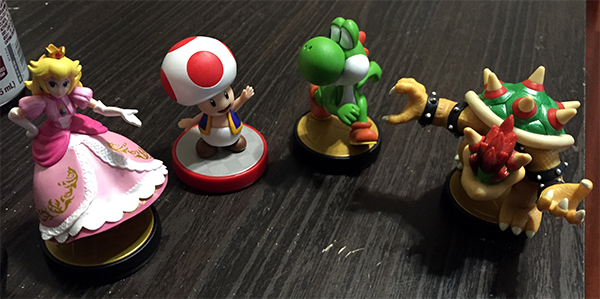
Before you start, you need to attach your amiibo the gamepad. You also need to attach your amiibo to the gamepad before you can acquire dice, use tokens, acquire new tokens, and so on. There is a lot of amiibo-to-gamepad touching that seems to be gimmicky for the sake of the newness of the amiibos, and it did slow down gameplay fairly significantly. However, this mode was still vastly more entertaining.
Guaranteed mini-matches meant that we actually got to play a fair number of them with a range of diversity. Tokens also changed the behavior of the board. In one case, there was a “large increase” in the number of stars on the board – seemingly tripling the number of available stars we could receive. In other cases, a quarter of the board was switched out for another player’s board to the point where in one game, we didn’t have a single slice of the original character’s board.... which was fine by me. As it happens, even though I chose Peach, I hated how sugary and pink her map was.
The small changes meant a lot in terms of gameplay; it required more attention, more skill, more thoughtfulness (we actually got to use the dice we received), and more tactics to avoid Bowser. In regular mode, we managed to avoid him altogether. The fact that we moved separately instead of as a unit mattered a lot, too. At least in that way, we weren’t playing a competitive game masquerading as a co-op.
Bowser Party Mode
In Bowser Mode, three friends tackle an insufferable Bowser who envisions screwing every last one of you in the most rage-inducing way possible. In this version, one person plays as Bowser and takes on the rest of the party. As with the rest of “Mario Party,” players roll to move forward on a map to escape Bowser, each starting with six hearts as your “life currency.” If Bowser rolls enough to catch up to your party – who all move forward together – then you engage in a mini game. If you win the mini-game, you keep your hearts. If you lose the mini-game, you lose a heart or more. If you lose all of your hearts, you’re out of the game. It’s as simple as that.
Because of the nature of the mode, it is both co-op (three friends together) and competitive (against Bowser), so you get the best of both worlds in that regard. Even if you don’t do well individually, you can at least pat yourself on the back knowing it you’ve continued the 20-year tradition of kicking Bowser to the curb.

Unlike other modes in the game – which is saying quite a bit – this mode relies heavily on RNG in order to succeed. However, Nintendo counters this by having the three members competing against Bowser to cooperate with one another. If Bowser wins, everyone else loses, so it makes sense to support your fellow gamers, right? Unfortunately for you, a player-controlled Bowser knows you better than a Nintendo developer ever could, and you may start further back than if you’d just taken on an AI. It’s simpler for Bowser to win at the mini-games as well, putting non-Bowser players at a further disadvantage. This mode is extremely frustrating, but the payoff is equally rewarding if you actually manage to succeed.
Which we did!
“I don’t know what just happened,” said Toad. “But we did it.”
Unfortunately, our fourth was unavailable, so we didn’t try out having a person as Bowser the way we were hoping. At 3 A.M., we weren’t operating at our most clever.
Amiibos
As expected, a new round of basic amiibos and some rare variations are available for the “Mario Party 10” release. I bought the “Party” version of Peach to keep my “Smash” Peach company, but there’s far more you can do with it than that. However, I want to give credit to Nintendo for allowing you to use “Smash” variations if you want to. A Peach is a Peach is a Peach - you don’t have to buy “Mario Party” version of amiibos to use this feature.
Customizations
Over the course of amiibo play or by using coins gained from completing challenges, you can customize the vehicles your characters ride in, the bases your amiibos stand on, or even extra characters. With the exception of bases, all customizations can be bought with coins earned. Over three games, we managed to earn 2,200 coins, enabling us to unlock both extra characters (Toadette and Spike), as well as all but two vehicles. While fun, these probably should have required more than a cursory run-through of each of the modes to access.
The most fun of these variations is the base-gathering. Since we played over midnight, we were able to earn two bases each for our amiibos while playing, which are surfaces your amiibos stand on while moving across the board. They’re silly, not relevant to gameplay, and even sort of random (one was a soccer ball), but they were amusing, and they add a little something “extra” for no reason at all. Papaya stands tall on her bronze base.
Overall Impressions
This game was fun, but not “$50 fun.” There was certainly enough material and variation to be enjoyable, and of course, the more the merrier. However, with 1/3 of the base game stale and uninteresting, Nintendo lags behind with its sub-par launch experience. I’ve got my hopes up that patches will increase its replay value, but at its current state, I’ll probably only bring it out when I’ve got exactly three other people and nothing else more fun to do.
There are about the same number of pros and cons for me; the cons just matter more.
